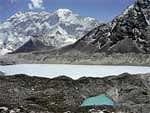
Think Himalayas and the picture of the Mount Everest comes to mind. The Himalayas conjure up visions of freezing ice-capped mountain tops, with snow blizzards and avalanches. Heroes like Sir Hillary and Tenzing Norgay climbed the world’s tallest peak and lived to tell the tale. They were able to overcome sub zero conditions to reach the top and proudly display their conquering flag. Vast tracts of inaccessible frozen glaciers, rocky cliffs and a massive peak, have been our images of the ‘roof of the world.’
The third pole
Fast forward to the 21st century and those glaciers and frozen ice covered peaks are being touched in a bizarre fashion. Their glaciers which are vast frozen stores of fresh water, the regions called the cryosphere, are beginning to melt with the effects of climate change. This is known as the planet’s ‘third pole’ which consists of the Himalayas and the Tibetan Plateau.
The third pole has more than 45,000 individual glaciers which feed all the major river systems of the region. The Yangtze, the Brahmaputra, the Yellow, the Mekong and the Salween are the main rivers of this region. The South Asian Himalayas are the source of these mighty rivers, which are the region’s lifeline to 1.3 billion people, who live in the plains. With the increase of global warming, these Himalayan glaciers are melting faster than projected and with the increase of flooding, rock avalanches, the very water source will be affected in the next three decades.
“The glaciers of the Himalayas are retreating faster than any other glaciers in the world,” said Nepal’s Prime Minister Madhav Kumar Nepal with great concern at a regional conference in Kathmandu recently. According to Syed Iqbal Hasnain, one of India’s foremost glaciologists from TERI, “The Third Pole is the water tower of Asia and bio-mass burning and coal fired power plants are the main forcing agent for this glacial melt,” says Hasnain.
“India and China are the biggest emitters of black carbon and these black carbon emissions are deposited on the ice and hang in the atmosphere. “These particles are heated by solar radiation, which cause the melting of the ice. Diesel fumes, burning of cow dung, coal fired power plants and burning of wood for cooking fuel is partly the cause of this glacial melt. One needs mountaineering skills to be able to climb and monitor glaciers.
“Drilling of nine to ten metres is undertaken after which the mass balance is measured. Then checking of whether it is negative or positive and how the entire mass is affected is measured.
“Due to the negative effects of CO2 on the glaciers, they have begun to melt and form glacial lakes. They are shrinking by both length and width at a staggering rate and the intensity of ice melt is higher on the Eastern side than the Western Himalayas. We have put up gauging stations to check both the mass balance and the energy balance (solar radiation) and thereby check how ice melt is being affected,” revealed Hasnain.
Director General of ICIMOD (International Centre for Integrated Mountain Development) Andreas Schild aid, “The impact of climate change in the Himalayas is becoming apparent. Studies show the impact of climate change on the Himalayan glaciers is a fact which has to be dealt with. Studies show that most valley glaciers are retreating. Vertical shifts of up to 100m have been recorded during the last 50 years with retreat rates of 50m per year. This shows glaciers are melting faster in recent decades. If the present trend continues it is estimated that most valley glacier trunks and smaller glaciers will disappear by 2050.”
Glacial lake floods
However what has been the fear factor to life with this glacial melt is that glacial lakes form with glacial retreat and many have been observed by scientists of ICIMOD at elevations of 4500m.
“With increasing amounts of water in these lakes, Glacial Lake Outburst Floods (GLOFs) are inevitable and have been happening,” says Schild. “These lakes burst their banks and destroy everything and anything in their path. The land is rendered useless once the outburst happens as glacial moraine and debris fills the area it has flooded.”
Climate change has the Indian glaciologists clearly stressed as they say these retreating glaciers and GLOFs will affect water resources and the livelihood of millions of people who live down stream, who depend on this water for agriculture and their very sustenance.